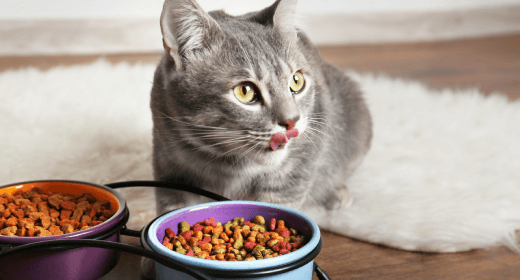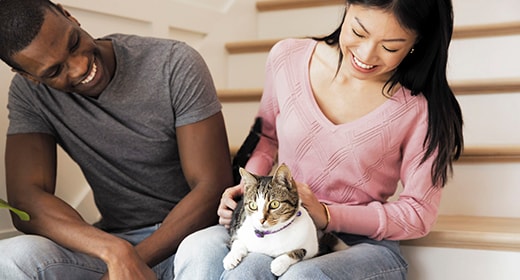

Good nutrition is as important to your cat as it is to you, but her nutritional needs are quite different! Unlike humans, a cat needs a high-fat diet with less fibre. Even if you prefer a vegetarian diet, you should understand that cats are carnivores. They need nutrients from animal protein and fat for optimal health, and they benefit from fibre for a healthy digestive tract and carbohydrates for energy.
With thousands of pet foods available, how do you pick the one that's right for your cat?
Start by identifying the cat's life stage and lifestyle. Kittens, nursing mothers, and mature/senior pets are examples of life stages, and each has different nutritional requirements. All cat foods should state which life stage they are recommended for.
Nutritional needs also vary depending on lifestyle. A cat whose primary activity is guarding the couch doesn't need as much energy as one who likes to spend time roaming outside.
Finally, it is important to take into account any special medical condition your cat may have, including food allergies that might require a special diet recommended by your veterinarian.
Once you've determined your cat's life stage and lifestyle needs, decide whether to feed dry or wet food. Most cats thrive on only dry food. This type of food promotes oral hygiene and health through abrasive action. Some cats, especially finicky eaters, enjoy the smooth and wet texture of canned or pouch foods.
Remember that, while dry food can be left in a bowl all day, wet food should be thrown away after 30 minutes if not eaten. Dry food is the best choice for busy people who are not normally home during the day.
Once you know your pet's nutritional needs and your pet's preference, you are ready to go shopping.
Because cats need the nutrients found in animal sources, it’s best to pick a food in which a primary ingredient (one of the first ones listed) is an animal-based protein source such as chicken, lamb, fish, egg, or one of their by-products. These ingredients contain all the essential amino acids, including taurine, which isn’t found in a vegetable-based protein source.
Using a combination of carbohydrates in a diet, such as corn meal or barley and grain sorghum, ensures efficient absorption and helps maintain energy levels. And beet pulp is an excellent fibre source that promotes a healthy digestive tract.
For a soft, thick coat and healthy skin, your pet needs fatty acids like those found in vitamin-rich fish oils and quality fat sources such as chicken.
Cat food labels provide limited information on the nutritional value of your pet's food because labeling regulations do not allow manufacturers to describe the quality of ingredients on the package. A reputable pet food manufacturer can explain to you how they evaluate and assure the quality of their products.
When choosing food, the price on the bag, while important, is usually not the best consideration. A low price may indicate cheap ingredients, or ingredients that change as manufacturer costs fluctuate.
In addition, many lower-priced products have higher daily portions to provide the same amount of nutrition found in a high-quality diet. To get a better idea of cost, it is the cost per feeding, not the total cost, that counts.
To figure cost per feeding, divide the total cost by the number of days the product lasts. For example, a 20-lb bag of food that costs $18.99 and lasts 30 days is $0.63 per day. A 20-lb bag that costs $15.99 and lasts 20 days costs $0.80 per day. When compared closely, high-quality pet foods are quite favourable to other brands.


Bringing a new kitten home can be exciting, especially if it is your first time. The day you have been looking forward to has finally arrived and you are ready to take on your responsibilities as a cat parent! However exciting it may be to embark on this journey, a caregiver should not forget to prepare their home for a kitten’s first day and night.
Start establishing a routine during your new kitten’s first week at home. For instance, start taking it to the vet, and introduce it to friends, family, and other pets. You should also be fully prepared for its first outings once it is fully vaccinated. Lastly, kitten-proofing your home is highly recommended. Bringing a new kitten home is no different than bringing a baby home. As a caregiver, you should put away all hazardous items in the house and create a safe space for your kitten.
For caregivers who are bringing a new kitten home, this article is the ideal read! Here’s what you need to know about introducing a new kitten to your home.
There are multiple things you need to do before getting a kitty into your house. For example, you must find a credible veterinarian in your vicinity. Especially because you have to take your newborn cat to the vet as soon as you adopt it. So, let’s explore other crucial steps to take before bringing a kitten home:
Kittens are tiny and delicate; hence, anything that can hurt or harm them should be put away. Make sure you have set up a sleeping space for your kitten, a food bowl, and a water bowl. Apart from that, place one or more litter boxes around your house depending on the size of your home. Make sure you cover any sharp edges of your furniture and don’t expose your kitten to any dangerous figures. Moreover, keep harmful plants and any toxic substances out of its reach.
For the first few nights, it is normal for new kittens to be anxious. It will take some time for a kitten to get used to its new home. It is also normal for your kitten to cry for the first few nights. You can make this experience better for it by setting up a cosy sleeping space. Once it gets comfortable in the new home, the kitty can even sleep for up to 20 hours a day.
It is not recommended to suddenly change your kitten’s food. Thus, find out what it was being fed by its previous caretaker. Stick to that meal plan for a few days and then gradually start changing your kitten’s diet. The best person to give you any advice on the right diet for kitties is a vet. Visit a veterinarian to receive a comprehensive feeding chart for your feline friend’s diet. For kittens between two to 12 months of age, IAMS Proactive Health Mother And Kitten dry food is ideal. It is loaded with protein, omega-3 fatty acids, vitamins, and minerals to support healthy brain and eye development. This kitten food also contains colostrum and DHA – two essential nutrients that provide immunity and protection against diseases.
Now, let’s take a deep dive into understanding the things that must be done once you have brought the kitty home:
The first step after bringing a kitten home is to introduce your new feline friend to its new family. Kittens can feel nervous around strangers; hence, familiarising them with their new family is imperative. Ensure that the atmosphere is calm and not too loud as they tend to get anxious. Your kitten should be handled gently if being picked up by anyone. Give your kitten the space it requires and let it explore the house by itself.
If you have any other pets or more cats, introducing a new kitten to the rest of them is important. After all, they have to coexist and should get along as soon as possible. The best way to make them accustomed to each other is through scent. Keep switching sleep blankets so your pets can get used to being around each other. You can also place one pet’s towel under the other’s food dish. By doing this, all your pets will slowly get used to the new kitten.
Maintaining your kitten’s health is a priority. One of the most important things to do as soon as you bring a new kitten home is to set up a vaccination plan with the vet. Hence, make sure you visit a veterinarian at the earliest. Stay consistent with all vaccination doses for your kitten’s overall well-being. Later on, start taking your pet for regular medical check-ups. The doctor will examine your kitten’s weight, teeth, ears, etc. to gauge its nutritional needs.
Once your kitten starts feeling a little comfortable in your house, it will start exploring the space. If you see your kitten roaming around, it is great news. This means that it has started trusting the people and environment. However, make sure your kitty doesn’t get hurt while exploring its new home. You also don’t want to keep interrupting your pet to protect it from sharp edges. Hence, do not skip kitten-proofing your house. When your kitten gets up to move around, resist the urge to cuddle; let it explore and find the most comfortable spot for itself.
We all know that a new kitten requires some time and space to adjust to its new surroundings. However, once your new feline friend is all settled in, you can start playing basic games with it. For instance, play with a string. Cats love to play hide-and-seek or peek-a-boo. Start rewarding it with treats when it plays with you. It will soon start trusting you. And when your kitty rubs its body against you, licks your hand, or shows any form of affection, you will know that you have earned its trust.